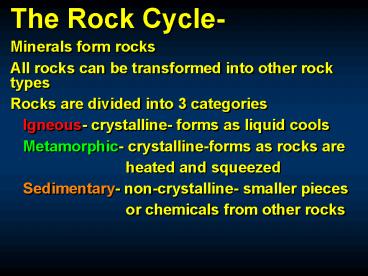PowerPoint Presentation Igneous Rocks - PowerPoint PPT Presentation
1 / 31
Title: PowerPoint Presentation Igneous Rocks
1
The Rock Cycle- Minerals form rocks All rocks can
be transformed into other rock types Rocks are
divided into 3 categories Igneous-
crystalline- forms as liquid cools
Metamorphic- crystalline-forms as rocks are
heated and squeezed
Sedimentary- non-crystalline- smaller pieces
or chemicals from other
rocks
2
(No Transcript)
3
Igneous formed from Magma and Lava
Magma
molten rock below Earth's
surface.
L
ava
magma on the Earth's surface.
Pyroclastic material
(
pyro
fire,
clastic
debris)
Airborne lava
cools as it falls
4
Composition of the magma
Analogous to what makes up the stew"
What chemical elements are present
What material has the magma moved through
Temperature of the melt
Not only how hot, but how long it stays that hot
also relates to pressure of the molten rock
Cooling environment
fast
vs
slow
Internal vs External
Water content
5
Bowen's Reaction Series-
not in your text, but important
Plagioclase
Olivine
(Ca-feldspar)
Pyroxene
Continuous
Discontinuous
Amphibole
Plagioclase
(Na-feldspar)
Biotite
Orthoclase
(K-feldspar)
Muscovite
Quartz
6
What things might you describe when looking at an
igneous rock?
7
Composition of Igneous rocks
Felsic or Sialic
magma
Si-rich (gt 65)
rich in K, and Al
little Ca, Fe, and Mg.
Intermediate magma
between the two extremes in Si
content and other atoms.
Mafic
magma
Si - poor (lt 35)
richer in Ca, Fe, and Mg.
8
Ways of Changing Magma Composition
9
Viscosity of Magma/ Lava
Viscosity of Magma/ Lava
Viscosity- important for volcanic activity
the resistance of a liquid to flow
the resistance of a liquid to flow
high viscosity thick and stiff
low viscosity thin and "runny".
Related to
Related to
amount of water (H2O) in magma
amount of silica (Si) in magma
Mafic
Mafic
thin, low viscosity
Felsic
Felsic
thick, high viscosity
10
(No Transcript)
11
Porphyritic texture
Large white crystals are phenocryts
Aphanitic basalt (mafic composition) constitutes
the groundmass
12
(No Transcript)
13
Categories of Igneous EOF
Granite
Intrusive rocks
cool beneath Earth's surface
cool very slowly
higher P T
Phaneritic textures
Rhyolite
Extrusive rocks
cool on the Earth's Surface
cool relatively fast
lower T P
Aphanitic textures
Basalt porphyry
Pyroclastic textures
Complex
Partially cools below and above
Porphyritic textures
14
Igneous rock names
determined by texture
size and arrangement of mineral grains
AND by mineral composition
minerals affect rock color and indicate
temperature of creation
15
(No Transcript)
16
(No Transcript)
17
Pegmatite
A Pegmatite is a very coarse-grained igneous rock.
Crystals are gt2 cm, often larger.
Most are granitic, although mafic pegmatites can
form.
Biotite mineral grain
Feldspar
mineral
grain
Quartz mineral
grain
18
What are the textures in these two rocks ?
19
What are the textures in these two rocks ?
20
Basalt Gabbro
phaneritic texture
aphanitic texture
forms from mafic magma
forms from mafic magma
Basalt
Gabbro
21
Peridotite- the abundance (more than 40) of
Olivine crystals makes the rock take on a green
appearance
22
Obsidian- conchoidal fracture And association
with volcanic rocks
Volcanic
Glass
23
Tuffs Breccias- look like sedimentary rock
Tuffs Breccias
But they are not.it is volcanic ash that is
lithified
24
How do we tell where the igneous rocks formed?
What can we derive from the rocks about the
conditions of formation?
25
Pyroclastics
Lava flow
Volcanic neck
Igneous dike
Igneous Sill
Batholith
26
Sierra Nevada Batholith- Home to Yosemite
National Park and a lot of Granites and
Grano-diorites
27
Sierra Nevada Batholith
28
(No Transcript)
29
Areal extent of the Idaho Batholith- a huge
(15,400 square miles) intrusive body of primarily
felsic composition (granites) igneous rocks
30
An igneous dike- Discordant with surrounding
rock It cuts across other rocks
An igneous sill- Concordant with surrounding
rock It runs parallel to other rocks
31
Volcanic Necks Igneous Dikes
Neck
Dike
igneous sill
Igneous sill































